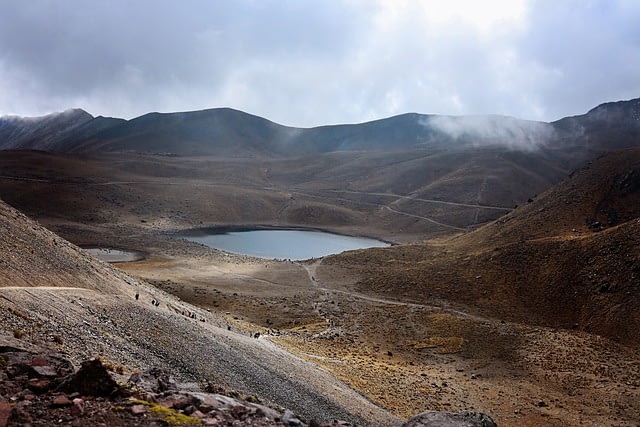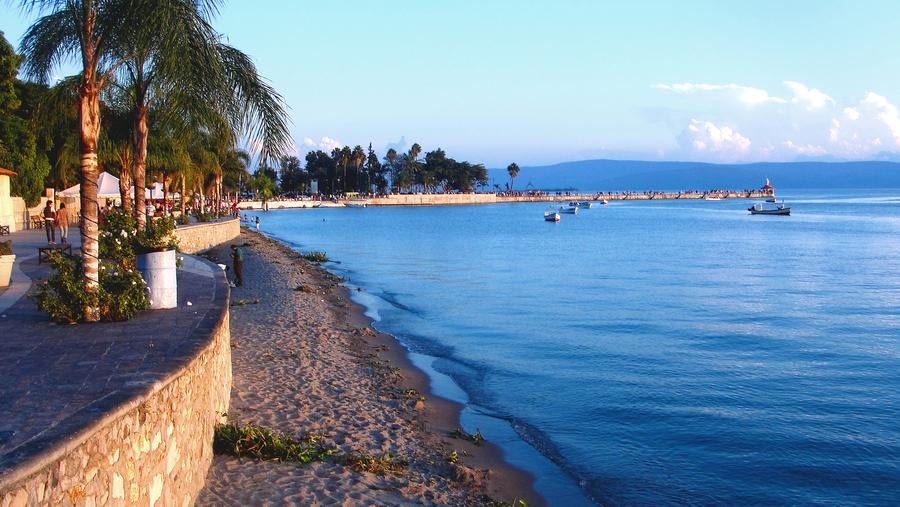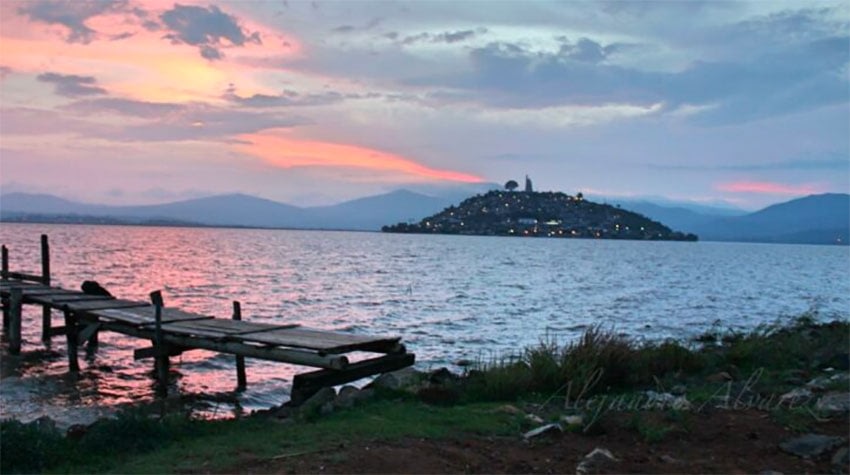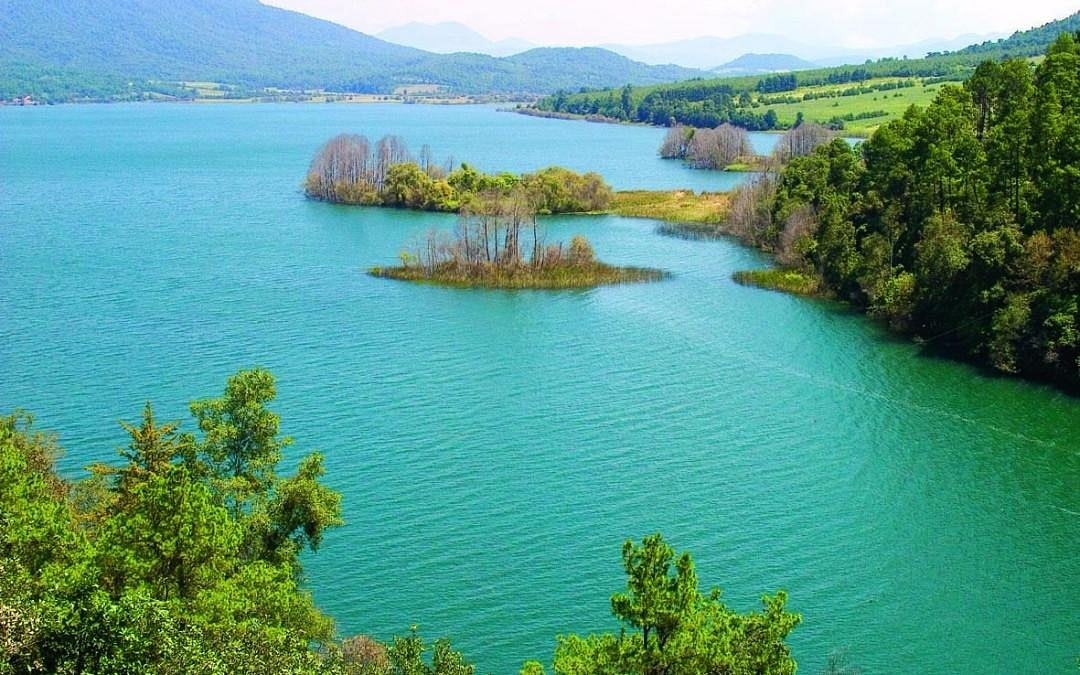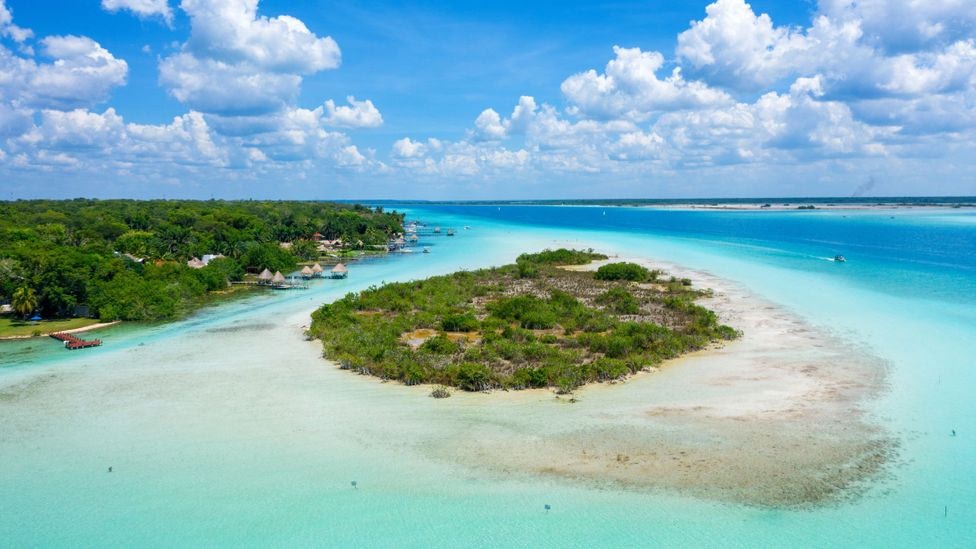With over 150 lakes scattered across its diverse landscape, Mexico is a dream destination for lake lovers looking to add a little water to their next trip planner. From the expanse of Lake Chapala to the festivities at Lake Pátzcuaro, the lakes of Mexico offer amazing scenery, outdoor activities, and rich cultural experiences. If you’re looking to add a Mexican lake or two to your upcoming travels, this list of the 5 most beautiful lakes in Mexico will help you choose the best ones to visit. Whether you want to relax lakeside, explore Aztec ruins, or experience local culture, there’s a perfect Mexican lake trip for every traveler. Keep reading for more on how to work these magnificent Mexican lakes into your next adventure!
#1 Lake Chapala
Nestled in the state of Jalisco, Lake Chapala is Mexico’s largest lake and an ideal spot for leisurely boat trips and watersports. The charming towns surrounding the lake, such as Ajijic and Chapala, overflow with culture and charm:
- Wander the cobblestone streets and browse boutique shops, restaurants, and colorful street markets.
- Visit the Malecon boardwalk in Chapala to shop, sample local food, and watch stunning sunsets over the water.
- Marvel at the bright murals and architecture in Ajijic, known as Mexico’s village of art.
- Hop aboard a boat cruise to birdwatch, fish, or relax with lake views.
Key Facts About Lake Chapala:
- Mexico’s largest lake at 77 x 19 miles wide
- Average depth of 14 feet, with the deepest point being about 90 feet
- Located at about 5,000 feet above sea level
- The main water source is mountain runoff from the Lerma River
- Home to hot springs, wetlands, migratory birds, and endemic species like the Chapala bass
Preparing for Travel to Lake Chapala:
- Book hotels, flights, and rental cars well in advance for peak season between October and April.
- Pack layers for the varying climate, from hot days to cool evenings.
- Get pesos before arriving, as many smaller towns rely on cash.
- Consider any accessibility needs for the cobblestone streets.
- Allow time to adjust to the altitude of around 5,000 feet.
The Best Time to Visit Lake Chapala:
The high season for Lake Chapala is between October and April, when snowbirds flock south and the weather is ideal for water activities. For smaller crowds, aim for May, September, or October. July and August can be very rainy.
#2 Lake Pátzcuaro
Located in Michoacán, Lake Pátzcuaro is known for its scenic islands and old monasteries. Janitzio Island is a top attraction with its stair-stepped streets, red-roofed buildings, and lively Day of the Dead festivities.
- Janitzio Island is a top attraction with its stair-stepped streets, red-roofed buildings, and lively Day of the Dead festivities.
- Visit 16th century Santa Fe de la Laguna, built on the lake, to see historic architecture.
- Take a boat ride to Isla Pacanda to wander the walking trails and sample local cuisine.
- Tour the Vasco de Quiroga Museum on an island linked by a causeway to Pátzcuaro village.
Key Facts About Lake Pátzcuaro:
- Located at 7,500 feet above sea level in the Trans-Mexican Volcanic Belt
- Has five islands, with Janitzio being the largest
- Surrounded by dormant volcanoes, including Patamban, along the north shore
- Holds indigenous ceremonies like the Night of the Dead and Fishing of the Souls.
- Known for arts & crafts like pottery, indigenous lacquerware, guitars, masks, and more
Preparing for Travel to Lake Pátzcuaro:
- Arrange a rental car or driver for the 3- to 4-hour drive from Mexico City.
- Reserve Janitzio Island day trips and fishing trips in advance.
- Pack walking shoes for exploring the lakeside towns.
- Practice some Spanish phrases to interact with the locals.
- Read up on the Day of the Dead traditions celebrated in October.
The Best Time to Visit Lake Pátzcuaro:
Visit in late October to experience Day of the Dead festivities. Between May and August, you’ll get reasonably priced accommodations and fewer tourists, though June-August are the rainiest months.
#3 Lake Texcoco
Once a sacred site for the Aztecs, much of Lake Texcoco has now dried up. However, you can still visit the remains and museums standing on the former lake bed near Mexico City.
- Wander through the Sculptural Space of Lake Texcoco, an outdoor museum with massive modern art installations.
- Visit the Chapultepec Ecological Park, built over the lake and featuring an aquarium and botanical gardens.
- Tour the MONARCA Peña del Aire exhibit to learn about the lake’s former ecosystem.
Key Facts About Lake Texcoco:
- Once one of the five great lakes in the Valley of Mexico
- Dried up significantly after Spanish settlers diverted its tributaries in the 17th century
- Former lake bed now contains various ecological, archeological, and cultural sites
- Remains include the chinampas, ingenious floating gardens built by the Aztecs
Preparing for Travel to Lake Texcoco:
- Stay in Mexico City to access Lake Texcoco sites via public transportation.
- Visit on weekdays to avoid crowds at top attractions.
- Wear good walking shoes and bring sun protection for outdoor areas.
- Carry cash for some site-specific vendors and souvenirs.
- Check museum schedules, as many are closed on Mondays.
The Best Time to Visit Lake Texcoco:
This area around Mexico City is comfortable year-round. April and May offer ideal weather without as many visitors. Museums and sites will be busiest during Mexican holidays like Semana Santa (Easter week).
#4 Lake Zirahuén
This crater lake in Michoacán offers postcard-perfect views of the surrounding mountains. Hike through pine forests along the lakeshore or try watersports like sailing among the tiny islands. Activities include:
- Hiking through pine forests along the lakeshore.
- Watersports like sailing among the tiny islands.
- Trying local cuisine in lakeside restaurants.
- Visiting the 17th century church, Iglesia de San Francisco Solanus.
Key Facts About Lake Zirahuén:
- A 1.5 mile wide volcanic crater lake about 6,500 feet above sea level
- Pine and oak forests surround the lake
- Formed between 20,000 – 10,000 years ago from volcanic eruptions
- Average depth of 150 feet, with the deepest point being about 230 feet
Preparing for Travel to Lake Zirahuén:
- Rent a car for the roughly 3.5-4 hour drive from Mexico City.
- Make accommodations ahead of time during the busy summer season.
- Bring binoculars for exceptional bird watching opportunities.
- Pack bug spray for exploring the lakeshore trails.
- Print out maps and directions, as cell service is limited.
The Best Time to Visit Lake Zirahuén:
Summer is peak season at Lake Zirahuén from June to August, when Mexicans vacation at the lakeside. For milder weather and thinner crowds, target March–May or September–November.
#5 Bacalar Lagoon
Nicknamed the “Lagoon of Seven Colors,” Bacalar Lagoon in Quintana Roo dazzles with its shades of blue. You can swim, kayak, or relax in a riverside cabana in this serene setting. You can:
- Swim, kayak, or relax in a riverside cabana in this serene setting.
- Visit the Fort of San Felipe Bacalar, built to protect the lagoon in the 18th century.
- Take an Instagram-worthy boat trip to swim in the lagoon’s cenotes.
- Shop for local souvenirs and try regional dishes in Bacalar town.
Key Facts About Bacalar Lagoon:
- Largest and most studied coastal lagoon in Mexico
- Fed by underground rivers, water filters through limestone, giving it vivid blues and greens
- Home to stromatolite reefs called “living rocks” estimated to be 3,500 years old
- Declared a Ramsar Wetland of International Importance in 2004
Preparing for Travel to Bacalar Lagoon:
- Fly into the Chetumal airport, which is about an hour from Bacalar, by taxi or rental car.
- Reserve lagoon tours and unique stays like lakefront cabanas in advance.
- Bring swimwear and water shoes to make the most of the swimming and boating.
- Apply eco-friendly sunscreen to protect the coral reefs.
- Check the visa requirements for entering and exiting Mexico.
The Best Time to Visit Bacalar Lagoon:
December to April make up the high season with the most sunshine, the least rain, and the bluest lagoon waters. You’ll get lower rates and more availability if you visit from May to November, outside of peak holiday times.
Conclusion:
In conclusion, Mexico’s lakes are breathtaking destinations offering beauty and cultural experiences. Whether you’re exploring Lake Chapala’s charm or enjoying the festivities at Lake Pátzcuaro, there’s something for everyone. To plan your trip easily, check out our trip planner app. Learn more about it here. Start planning your adventure today and dive into the wonders of Mexico’s lakes!

